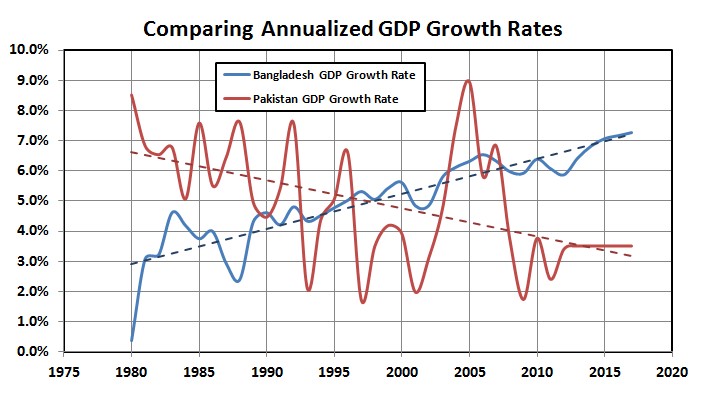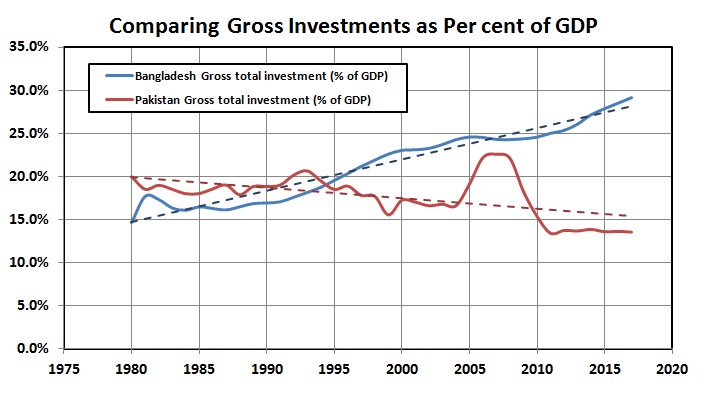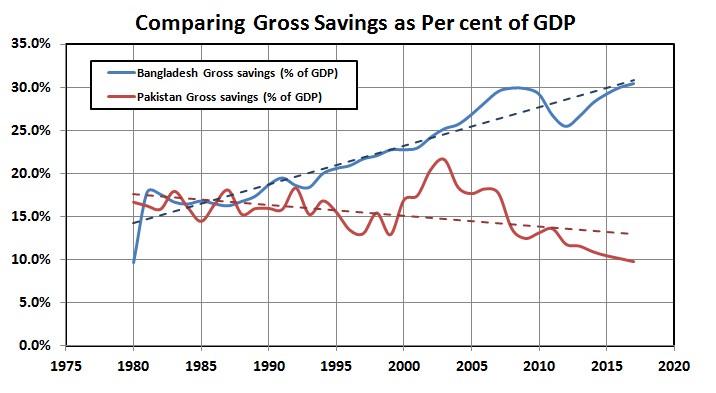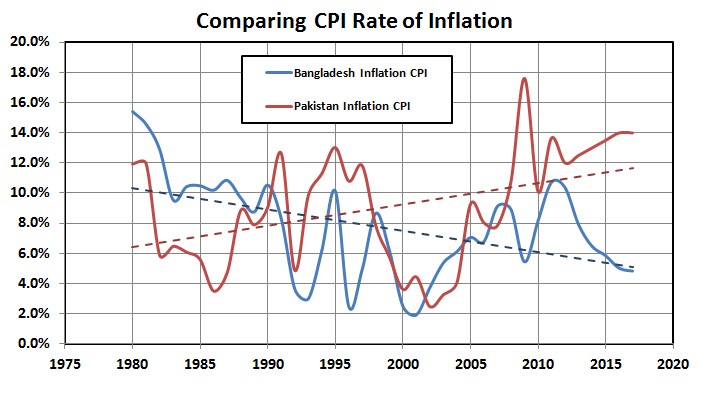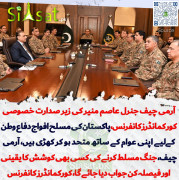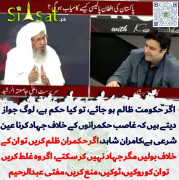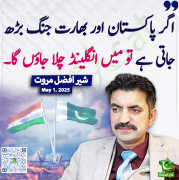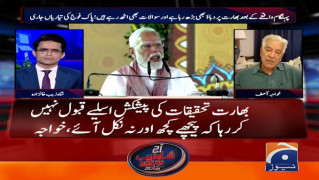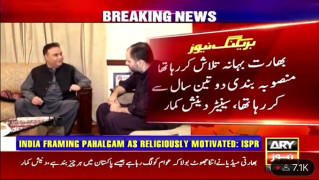btghazwa
Politcal Worker (100+ posts)
You must know what happened in East Pakistan so that we don't make the same mistakes again. The Indian funded media says that it was the fault of the army. That we have cleared in our previous post on East Pakistan. Now see the global players -- The Soviets, RAW and the CIA and their deliberate plans to create terrorist gangs like Mukti Bahini -- just as they are doing with TZP and BLA and MQM today --- to break Pakistan. An ex-KGB spy finally tells the dirty secret. The Kufr is One millat when is comes to Pakistan and Islam.
Muslims of Bangladesh must wake up now. For 40 years, they have been fed with these lies that they have taken "independence" from Pakistan. Enemies made a fool of them and exploited them to break Medina e Sani. If Bangladesh wants to be part of Ummah, then they must also ponder the crimes of their founding fathers who sided with the Kuffar against Ummat e Rasul (sm). We shall also expose the fake stories of "atrocities" committed by Pak army. Now after 41 years, the truth is out. People from India and Bangladesh are now coming out with truth. That we shall post later. These stories were also part of lies and propaganda against Pakistan. For now, listen to this Soviet spy.[video]http://blip.tv/btghazwa/crimes-against-medina-e-sani-pakistan-the-agartala-conspiracy-6045890[/video]
[video]http://blip.tv/btghazwa/east-pakistan-the-untold-story-zaid-hamid-5945305[/video]
For the last 41 years, the Indian and RAW funded snakes in media like Hamid Mir have been barking that Pakistan army committed the genocide of Bengali Muslims in East Pakistan. The Muslims of Bangladesh still believe these lies as all history was written by Indian army and RAW who had taken over all records of history after fall of Dhaka in 1971. Now after decades, Bengali leaders are coming forwards to expose the lies which have been spread for the last 4 decades. It is time that Muslims of Bangladesh also realize that how Indians and Soviets made a total fool of them and used their leaders to break away from Pakistan. The horrendous atrocities were indeed committed but NOT by Pak army but by the Mukt Bahini, as recorded in Blood and Tears.
The total strength of Pak army was 40,000 in East Pakistan. Total number of prisoners of war were 92,000 which included thousands of Pakistan government officials, civilians, pro-Pakistan citizens and post offices railways and PIA officers and staff. It is NOT humanly possible to commit that levels of genocide as being accused on Pakistan army. Now even the finest of Bengali leaders are comming forward to expose the lies. Their Zameer is hurting them now. They have betrayed the Ummat e Rasul (sm) and now when death is staring them in the face, they want to clean their conscious. read this and know how the snakes in media and politics lied to you.
Behind the myth of 3 million: true story of bloody birth of Bangladesh
Did Pakistan commit genocide and kill 3 million people in East Pakistan in 1971?
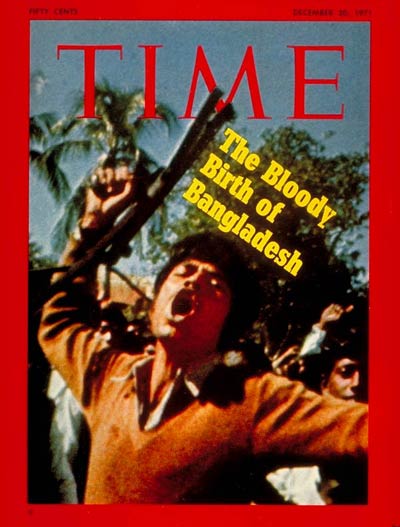
Dr. M. Abdul Mu’min Chowdhury, a Bengali nationalist who actively participated in the separatist cause, spoke out in 1996 to tell the true story of what went on during that war. He says the allegations against Pakistan were entirely cooked up and the actual death toll was much lower than the falsely fabricated 3 million figure. He cited an extensive range of sources to show that what the Pakistani army was carrying out in East Pakistan was a limited counter-insurgency, not at all a genocide.
He questions the conventional narrative of an oppressed, downtrodden Bengali nation fighting a brave and noble war of “liberation” from a tyrannical regime in the face of impossible hardship only to emerge as a free nation to whom the future now belonged. He says that greed for personal power and Indian predatory ambitions against its only regional counterweight were the only things that motivated the players who incited the breakup of the only homeland created for the Muslims of the subcontinent.
He explains how the allegations of genocide were artificially cooked up and from where the “absolutely impossible” 3 million figure was hatched, and anyone who tried to dig for the real truth in those days was murdered. He gives research-based details of each major incident that was blamed on Pakistan: the killing of intellectuals in Dhaka University, killings elsewhere in Dhaka, the murder of 5,000 Buddhists and 17,000 Awami Leaguers, the massacres and destruction visited on Kushtia, Jessore, Khulna and Chittagong, and the rapes of 400,000 women resulting in 200,000 pregnancies.
He then goes on to explain another category of atrocities committed by the so-called “liberators” that anti-Pakistan propagandists have whitewashed from all historic record, these were carried out against large numbers of East Pakistanis that fought for Pakistan and just about everyone who did not support Mukti Bahini. He describes the savage and gruesome ways they (he gives actual names and credentials of the victims) were murdered and otherwise brutalized and recounts the stories survivors themselves told, and apportions responsibility directly to Mukti Bahini and Sheikh Mujib-ur-Rehman, who was an Indian collaborator since the mid-1950s.
He says the true story must be told otherwise Bangladesh will never be a truly free nation and a normal member of the international community or the comity of Islamic nations. He says only the truth will enable reconciliation between Pakistanis and Bengalis and enable them to move on from the past and move toward the future together as brotherly nations like they used to be at one time.
----------------------------------------------------------
Sharmila Bose is an Indian, a Bengali and a Hindu. Read what she has to say about the most daring and courageous battle in East Pakistan fought by Pak arm against overwhelmingly superior Indian force. There were only 40,000 Pak army without air force, without Navy and without Tanks against nearly half a million (500,000) Indian army and Mukto Bahini supported by Tanks, air force, aircraft carriers and artillery. The battle was impossible from the beginning but still Pak army fought bravely to give time to Zulfiqar Ali Bhutto to find a political settlement.
DO NOT forget that after 1970 elections, Bhutto was running the government in Islamabad. Fall of Dhaka took place in December 1971. Bhutto had One full year to find a political settlement but he deliberately delayed and even tore apart the resolution of cease fire in United Nations. Pakistan army fought with such courage that now even the Indian Bengali Hindus are forced to acknowledge their greatness. read and arm yourself with knowledge. The blood of breaking Pakistan is on the hands of Bhutto and Mujeeb ur rehman NOT Pak army.
The Courageous Pakistan Army’s Stand on the Eastern Front by Sarmila Bose
The Courageous Pakistan Army’s Stand on the Eastern Front: An Untold Story of 1971 Indo-Pak War
By SHARMILA BOSE
THERE is much for Pakistan to come to terms with what happened in 1971. But the answers don’t lie in unthinking vilification of the fighting men who performed so well in the war against such heavy odds in defense of the national policy. Rather, in failing to honour them, the nation dishonours itself.
My introduction to international politics was 1971, as a schoolgirl in Calcutta. Many images from that year are still etched in my mind, but the culminating one was the photo on Ramna Race Course of two men sitting at a table — the smart, turbaned Sikh, ‘our’ war-hero, Jagjit Singh Aurora, and the large man in a beret, A A K Niazi, commander of the other side, signing the instrument of surrender. Nearly a generation later, a chance interview for the BBC (British Broadcasting Corporation) with Lt Gen. Aurora took me back to 1971. The interview was not about 1971, but about injustices suffered by Sikhs at the hands of the state General Aurora had served. I thought he was a bigger hero for what he had to say then. That view was reinforced as I read — with incredulity — the disparaging remarks by other Indian officers about him, and each other, in their books. If this is what happened to the winning commander, I wondered what had happened to the other man in the photo.
The result was a revelation.
It turns out that General Niazi has been my ‘enemy’ since the Second World War. As Netaji Subhas Chandra Bose and his Indian National Army fought on the Burma front in 1943-45 in their quest for India’s freedom, Niazi was fighting on the other side, for the British Indian Army, under the overall command of General (later Field Marshal) William Joseph Slim. Slim and his 14th Army halted the advance of the INA and the Japanese at the Imphal campaign and turned the course of the war.
In the process of inflicting military defeat upon my ancestor, Niazi’s performance was so exceptional that the British awarded him an on-the-spot Military Cross for action on the Assam-Burma front in June 1944. On another occasion they wanted to award a DSO, but he was too junior, so a Mention in Despatches was recorded. In the original record of his MC signed by his commanding officers all the way up to Slim, which I obtained from the British Ministry of Defence, the British commanders describe Niazi’s gallantry in detail: “He organized the attack with such skill that his leading platoon succeeded in achieving complete surprise over the enemy.” They speak of how he personally led his men, the ‘great skill and coolness’ under fire with which he changed tactics with changing circumstances, created diversionary attacks, extricated his wounded, defeated the enemy and withdrew his men by section, remaining personally at the rear in every case.
The British honoured Niazi for “personal leadership, bravery and complete disregard for his own personal safety.” On 15 December 1944 the Viceroy Lord Wavell flew to Imphal and in the presence of Lord Mountbatten knighted Slim and his corps commanders Stopford, Scoones and Christison. Only two ‘Indian’ officers were chosen to be decorated by the Viceroy at that ceremony — ‘Tiger’ Niazi was one of them.
In 1971 Niazi was a highly decorated Pakistani general, twice receiving the Hilal-e-Jurat. He was sent to East Pakistan in April 1971 — part of a sorry tradition in South Asia of political rulers attempting to find military solutions to political problems. By then Tikka Khan had already launched the crackdown of 25 March for which he has been known to Bengalis as the ‘Butcher of Bengal’ ever since. The population of East Bengal was completely hostile and Pakistan was condemned around the world.
Authoritative scholarly analyses of 1971 are rare. The best work is Richard Sisson and Leo Rose’s War and Secession.
Robert Jackson, fellow of All Soul’s College, Oxford, wrote an account shortly after the events. Most of the principal participants did not write about it, a notable exception being Gen. Niazi’s recent memoirs (1998).Some Indian officers have written books of uneven quality — they make for an embarrassing read for what the Indians have to say about one another.
However, a consistent picture emerges from the more objective accounts of the war. Sisson and Rose describe how India started assisting Bengali rebels since April, but “the Mukti Bahini had not been able to prevent the Pakistani army from regaining control over all the major urban centers on the East Pakistani-Indian border and even establishing a tenuous authority in most of the rural areas.” From July to October there was direct involvement of Indian military personnel. “…mid-October to 20 November… Indian artillery was used much more extensively in support …and Indian military forces, including tanks and air power on a few occasions, were also used…Indian units were withdrawn to Indian territory once their objectives had been brought under the control of the Mukti Bahini — though at times this was only for short periods, as, to the irritation of the Indians, the Mukti Bahini forces rarely held their ground when the Pakistani army launched a counterattack.”
Clearly, the Pakistani army regained East Pakistan for their masters in Islamabad by April-May, creating an opportunity for a political settlement, and held off both Bengali guerrillas and their Indian supporters till November, buying more time — time and opportunity that Pakistan’s rulers and politicians failed to utilise.
Contrary to Indian reports, full-scale war between India and Pakistan started in East Bengal on 21 November, making it a four-week war rather than a ‘lightning campaign’. Sisson and Rose state bluntly: “After the night of 21 November…Indian forces did not withdraw. From 21 to 25 November several Indian army divisions…launched simultaneous military actions on all of the key border regions of East Pakistan, and from all directions, with both armored and air support.” Indian officers like Sukhwant Singh and Lachhman Singh write quite openly in their books about India invading East Pakistani territory in November, which they knew was ‘an act of war’.
None of the outside scholars expected the Eastern garrison to withstand a full Indian invasion. On the contrary, Pakistan’s longstanding strategy was “the defense of the east is in the west”. Jackson writes, “Pakistani forces had largely withdrawn from scattered border-protection duties into cleverly fortified defensive positions at the major centres inside the frontiers, where they held all the major ‘place names’ against Mukti Bahini attacks, and blocked the routes of entry from India…”
Sisson and Rose point out the incongruity of Islamabad tolerating India’s invasion of East Pakistani territory in November. On 30 November Niazi received a message from General Hamid stating, “The whole nation is proud of you and you have their full support.” The same day Islamabad decided to launch an attack in the West on 2 December, later postponed to 3 December, after a two-week wait, but did not inform the Eastern command about it. According to Jackson, the Western offensive was frustrated by 10 December.
Though futile, the Western offensive allowed India to openly invade the East, with overwhelming advantages. “ …despite all these advantages, the war did not go as smoothly and easily for the Indian army…”, but Sisson and Rose come to the balanced judgment that “The Pakistanis fought hard and well; the Indian army won an impressive victory.” Even Indian officers concede the personal bravery of Niazi and the spirited fight put up by the Pakistanis in the East. That the troops fought so well against such overwhelming odds is a credit both to them, and to their commanders, for an army does not fight well in the absence of good leadership.
However, as Jackson put it, “…India’s success was inevitable from the moment the general war broke out — unless diplomatic intervention could frustrate it.” As is well known, Pakistan failed to secure military or diplomatic intervention. Sisson and Rose also say, “The outcome of the conflict on the eastern front after 6 December was not in doubt, as the Indian military had all the advantages.” On 14 December Niazi received the following message from Yahya Khan: “You have fought a heroic battle against overwhelming odds. The nation is proud of you …You have now reached a stage where further resistance is no longer humanly possible nor will it serve any useful purpose… You should now take all necessary measures to stop the fighting and preserve the lives of armed forces personnel, all those from West Pakistan and all loyal elements…” Sisson and Rose naturally describe this message as “implying that the armed forces in East Pakistan should surrender”.
No matter how traumatic the outcome of 1971 for Pakistan, the Eastern command did not create the conflict, nor were they responsible for the failure of the political and diplomatic process. Sent to do the dirty work of the political manoeuvrers, the fighting men seem to have performed remarkably well against overwhelming odds. It is shocking therefore to discover that they were not received with honour by their nation on their return. Their commander, Niazi, appears to have been singled out, along with one aide, to be punished arbitrarily with dismissal and denial of pension, without being given the basic right to defend himself through a court-martial, which he asked for.
The commission set up allegedly to examine what had happened in 1971 was too flawed in its terms of reference and report to have any international credibility. However, even its recommendations of holding public trials and courtmartials were ignored. There is much for Pakistan to come to terms with what happened in 1971. But the answers don’t lie in unthinking vilification of the fighting men who performed so well in the war against such heavy odds in defence of the national policy. Rather, in failing to honour them, the nation dishonours itself.
Sarmila Bose is the niece of Subhas Chandra Bose or Netaji of Indian National Army fame who fought against the British supporting the Japanese. He is considered as a great hero in Bengal and India.Sharmila Bose is Assistant Editor, Ananda Bazar Patrika, India & Visiting Scholar, Elliott School of International Affairs, George Washington University.
-----------------------------------------------------------------------------------------------------------------------------------------------------------------
Now read about battle of Hilli, where 3500 Pakistani troops of a single Brigade fought a desperate and daring battle with nearly 20,000 heavily armed Indian Division and stopped their advance. Major Akram Shaheed Nishan e Haider fought and died in this epic battle. East Pakistan's battles were most heroic battles fought by our army which was surrounded from all sides and was left to fight and die on its own where treason of the leaders and politicians had destroyed Pakistan's unity.
This battle was also unique in that it had started before the official start of the India Pakistan war but continued right until the formal surrender of Pakistan. Unlike other battles in the East where the Indian army dominated, Pakistan forces gave a very good account of themselves before the combined might of the Indian military managed to occupy the area. The Indians were so impressed by General Tajammul Hussain Malik’s fighting tactics that after the war the Indians had sent a team of experts to study the battle on the ground and determine reasons why such a heavy force as described above could not break through that sector until the end.
Imagine a battle: nearly 140 infantry soldiers of Pak army led by a Captain fighting and blocking 4000 heavily armed tank and air supported Indian troops for 21 days !!
This was the battle of Kamalpur in East Pakistan in 1971. That is how Pak army fought in most impossible conditions!
Read now and hold your breadth.
On the other hand Captain Ahsan Malik did not lose his nerve when much worse was happening in his area and he was fighting an unwinnable battle against overwhelming odds.
At about 0930 on 4 December, 'after withdrawing his troops from close siege, Kler 'hammered the post with seven sorties of MiG 21s firing rockets and cannon and this was repeated twice later in the day'.[6]Maj. General Gurbux Singh (commander of the north region) himself entered affairs by sending Captain Malik a note by a Mukti Bahini courier:'...whatever you decide to do we have every intention of eliminating Kamalpur post. It is to save you and our side casualties this message is being sent to you...'. He sent another note after a further air strike and this was met, as had been the other messages, by increased firing by Malik's men. But it could not go on, Malik received the order by radio to surrender, which he did at 1900 that day.
'He had,'as Sukhwant Singh goes on to say,'put up a courageous stand....and surrendered after holding a brigade of besiegers for 21 days....Sam Manekshaw sent a personal congratulatory message to Malik commending his defiant stand.' and wrote 'Militarily his performance was excellent'.[4][7]
Maj. Gen. Gurbux Singh decided to meet Malik personally but, while being driven towards Kamalpur by Kler to meet the brave Captain, their jeep went over a mine and he was badly wounded.
When Captain Ahsan Malik's force was taken in, it was found that his company was nearly out of ammunition, barring a few hand grenades and a few bullets each. They were ready to fling themselves on the enemy with daggers and bayonets if it came to that, until they realized that the piece of territory they were defending was already a different country. Nothing remained there to die for.
When he returned to Pakistan, he was decorated with a Sitara-e-Jurrat which is the third highest military award in Pakistan. Later on, Field Marshal Manekshaw acknowledged the bravery of his men in a letter written to his Pakistani counterpart.
The book Blood and Tears by Qutubuddin Aziz
Muslims of Bangladesh must wake up now. For 40 years, they have been fed with these lies that they have taken "independence" from Pakistan. Enemies made a fool of them and exploited them to break Medina e Sani. If Bangladesh wants to be part of Ummah, then they must also ponder the crimes of their founding fathers who sided with the Kuffar against Ummat e Rasul (sm). We shall also expose the fake stories of "atrocities" committed by Pak army. Now after 41 years, the truth is out. People from India and Bangladesh are now coming out with truth. That we shall post later. These stories were also part of lies and propaganda against Pakistan. For now, listen to this Soviet spy.[video]http://blip.tv/btghazwa/crimes-against-medina-e-sani-pakistan-the-agartala-conspiracy-6045890[/video]
[video]http://blip.tv/btghazwa/east-pakistan-the-untold-story-zaid-hamid-5945305[/video]
For the last 41 years, the Indian and RAW funded snakes in media like Hamid Mir have been barking that Pakistan army committed the genocide of Bengali Muslims in East Pakistan. The Muslims of Bangladesh still believe these lies as all history was written by Indian army and RAW who had taken over all records of history after fall of Dhaka in 1971. Now after decades, Bengali leaders are coming forwards to expose the lies which have been spread for the last 4 decades. It is time that Muslims of Bangladesh also realize that how Indians and Soviets made a total fool of them and used their leaders to break away from Pakistan. The horrendous atrocities were indeed committed but NOT by Pak army but by the Mukt Bahini, as recorded in Blood and Tears.
The total strength of Pak army was 40,000 in East Pakistan. Total number of prisoners of war were 92,000 which included thousands of Pakistan government officials, civilians, pro-Pakistan citizens and post offices railways and PIA officers and staff. It is NOT humanly possible to commit that levels of genocide as being accused on Pakistan army. Now even the finest of Bengali leaders are comming forward to expose the lies. Their Zameer is hurting them now. They have betrayed the Ummat e Rasul (sm) and now when death is staring them in the face, they want to clean their conscious. read this and know how the snakes in media and politics lied to you.
Behind the myth of 3 million: true story of bloody birth of Bangladesh
Did Pakistan commit genocide and kill 3 million people in East Pakistan in 1971?

Dr. M. Abdul Mu’min Chowdhury, a Bengali nationalist who actively participated in the separatist cause, spoke out in 1996 to tell the true story of what went on during that war. He says the allegations against Pakistan were entirely cooked up and the actual death toll was much lower than the falsely fabricated 3 million figure. He cited an extensive range of sources to show that what the Pakistani army was carrying out in East Pakistan was a limited counter-insurgency, not at all a genocide.
He questions the conventional narrative of an oppressed, downtrodden Bengali nation fighting a brave and noble war of “liberation” from a tyrannical regime in the face of impossible hardship only to emerge as a free nation to whom the future now belonged. He says that greed for personal power and Indian predatory ambitions against its only regional counterweight were the only things that motivated the players who incited the breakup of the only homeland created for the Muslims of the subcontinent.
He explains how the allegations of genocide were artificially cooked up and from where the “absolutely impossible” 3 million figure was hatched, and anyone who tried to dig for the real truth in those days was murdered. He gives research-based details of each major incident that was blamed on Pakistan: the killing of intellectuals in Dhaka University, killings elsewhere in Dhaka, the murder of 5,000 Buddhists and 17,000 Awami Leaguers, the massacres and destruction visited on Kushtia, Jessore, Khulna and Chittagong, and the rapes of 400,000 women resulting in 200,000 pregnancies.
He then goes on to explain another category of atrocities committed by the so-called “liberators” that anti-Pakistan propagandists have whitewashed from all historic record, these were carried out against large numbers of East Pakistanis that fought for Pakistan and just about everyone who did not support Mukti Bahini. He describes the savage and gruesome ways they (he gives actual names and credentials of the victims) were murdered and otherwise brutalized and recounts the stories survivors themselves told, and apportions responsibility directly to Mukti Bahini and Sheikh Mujib-ur-Rehman, who was an Indian collaborator since the mid-1950s.
He says the true story must be told otherwise Bangladesh will never be a truly free nation and a normal member of the international community or the comity of Islamic nations. He says only the truth will enable reconciliation between Pakistanis and Bengalis and enable them to move on from the past and move toward the future together as brotherly nations like they used to be at one time.
----------------------------------------------------------
Sharmila Bose is an Indian, a Bengali and a Hindu. Read what she has to say about the most daring and courageous battle in East Pakistan fought by Pak arm against overwhelmingly superior Indian force. There were only 40,000 Pak army without air force, without Navy and without Tanks against nearly half a million (500,000) Indian army and Mukto Bahini supported by Tanks, air force, aircraft carriers and artillery. The battle was impossible from the beginning but still Pak army fought bravely to give time to Zulfiqar Ali Bhutto to find a political settlement.
DO NOT forget that after 1970 elections, Bhutto was running the government in Islamabad. Fall of Dhaka took place in December 1971. Bhutto had One full year to find a political settlement but he deliberately delayed and even tore apart the resolution of cease fire in United Nations. Pakistan army fought with such courage that now even the Indian Bengali Hindus are forced to acknowledge their greatness. read and arm yourself with knowledge. The blood of breaking Pakistan is on the hands of Bhutto and Mujeeb ur rehman NOT Pak army.
The Courageous Pakistan Army’s Stand on the Eastern Front by Sarmila Bose
The Courageous Pakistan Army’s Stand on the Eastern Front: An Untold Story of 1971 Indo-Pak War
By SHARMILA BOSE
THERE is much for Pakistan to come to terms with what happened in 1971. But the answers don’t lie in unthinking vilification of the fighting men who performed so well in the war against such heavy odds in defense of the national policy. Rather, in failing to honour them, the nation dishonours itself.
My introduction to international politics was 1971, as a schoolgirl in Calcutta. Many images from that year are still etched in my mind, but the culminating one was the photo on Ramna Race Course of two men sitting at a table — the smart, turbaned Sikh, ‘our’ war-hero, Jagjit Singh Aurora, and the large man in a beret, A A K Niazi, commander of the other side, signing the instrument of surrender. Nearly a generation later, a chance interview for the BBC (British Broadcasting Corporation) with Lt Gen. Aurora took me back to 1971. The interview was not about 1971, but about injustices suffered by Sikhs at the hands of the state General Aurora had served. I thought he was a bigger hero for what he had to say then. That view was reinforced as I read — with incredulity — the disparaging remarks by other Indian officers about him, and each other, in their books. If this is what happened to the winning commander, I wondered what had happened to the other man in the photo.
The result was a revelation.
It turns out that General Niazi has been my ‘enemy’ since the Second World War. As Netaji Subhas Chandra Bose and his Indian National Army fought on the Burma front in 1943-45 in their quest for India’s freedom, Niazi was fighting on the other side, for the British Indian Army, under the overall command of General (later Field Marshal) William Joseph Slim. Slim and his 14th Army halted the advance of the INA and the Japanese at the Imphal campaign and turned the course of the war.
In the process of inflicting military defeat upon my ancestor, Niazi’s performance was so exceptional that the British awarded him an on-the-spot Military Cross for action on the Assam-Burma front in June 1944. On another occasion they wanted to award a DSO, but he was too junior, so a Mention in Despatches was recorded. In the original record of his MC signed by his commanding officers all the way up to Slim, which I obtained from the British Ministry of Defence, the British commanders describe Niazi’s gallantry in detail: “He organized the attack with such skill that his leading platoon succeeded in achieving complete surprise over the enemy.” They speak of how he personally led his men, the ‘great skill and coolness’ under fire with which he changed tactics with changing circumstances, created diversionary attacks, extricated his wounded, defeated the enemy and withdrew his men by section, remaining personally at the rear in every case.
The British honoured Niazi for “personal leadership, bravery and complete disregard for his own personal safety.” On 15 December 1944 the Viceroy Lord Wavell flew to Imphal and in the presence of Lord Mountbatten knighted Slim and his corps commanders Stopford, Scoones and Christison. Only two ‘Indian’ officers were chosen to be decorated by the Viceroy at that ceremony — ‘Tiger’ Niazi was one of them.
In 1971 Niazi was a highly decorated Pakistani general, twice receiving the Hilal-e-Jurat. He was sent to East Pakistan in April 1971 — part of a sorry tradition in South Asia of political rulers attempting to find military solutions to political problems. By then Tikka Khan had already launched the crackdown of 25 March for which he has been known to Bengalis as the ‘Butcher of Bengal’ ever since. The population of East Bengal was completely hostile and Pakistan was condemned around the world.
Authoritative scholarly analyses of 1971 are rare. The best work is Richard Sisson and Leo Rose’s War and Secession.
Robert Jackson, fellow of All Soul’s College, Oxford, wrote an account shortly after the events. Most of the principal participants did not write about it, a notable exception being Gen. Niazi’s recent memoirs (1998).Some Indian officers have written books of uneven quality — they make for an embarrassing read for what the Indians have to say about one another.
However, a consistent picture emerges from the more objective accounts of the war. Sisson and Rose describe how India started assisting Bengali rebels since April, but “the Mukti Bahini had not been able to prevent the Pakistani army from regaining control over all the major urban centers on the East Pakistani-Indian border and even establishing a tenuous authority in most of the rural areas.” From July to October there was direct involvement of Indian military personnel. “…mid-October to 20 November… Indian artillery was used much more extensively in support …and Indian military forces, including tanks and air power on a few occasions, were also used…Indian units were withdrawn to Indian territory once their objectives had been brought under the control of the Mukti Bahini — though at times this was only for short periods, as, to the irritation of the Indians, the Mukti Bahini forces rarely held their ground when the Pakistani army launched a counterattack.”
Clearly, the Pakistani army regained East Pakistan for their masters in Islamabad by April-May, creating an opportunity for a political settlement, and held off both Bengali guerrillas and their Indian supporters till November, buying more time — time and opportunity that Pakistan’s rulers and politicians failed to utilise.
Contrary to Indian reports, full-scale war between India and Pakistan started in East Bengal on 21 November, making it a four-week war rather than a ‘lightning campaign’. Sisson and Rose state bluntly: “After the night of 21 November…Indian forces did not withdraw. From 21 to 25 November several Indian army divisions…launched simultaneous military actions on all of the key border regions of East Pakistan, and from all directions, with both armored and air support.” Indian officers like Sukhwant Singh and Lachhman Singh write quite openly in their books about India invading East Pakistani territory in November, which they knew was ‘an act of war’.
None of the outside scholars expected the Eastern garrison to withstand a full Indian invasion. On the contrary, Pakistan’s longstanding strategy was “the defense of the east is in the west”. Jackson writes, “Pakistani forces had largely withdrawn from scattered border-protection duties into cleverly fortified defensive positions at the major centres inside the frontiers, where they held all the major ‘place names’ against Mukti Bahini attacks, and blocked the routes of entry from India…”
Sisson and Rose point out the incongruity of Islamabad tolerating India’s invasion of East Pakistani territory in November. On 30 November Niazi received a message from General Hamid stating, “The whole nation is proud of you and you have their full support.” The same day Islamabad decided to launch an attack in the West on 2 December, later postponed to 3 December, after a two-week wait, but did not inform the Eastern command about it. According to Jackson, the Western offensive was frustrated by 10 December.
Though futile, the Western offensive allowed India to openly invade the East, with overwhelming advantages. “ …despite all these advantages, the war did not go as smoothly and easily for the Indian army…”, but Sisson and Rose come to the balanced judgment that “The Pakistanis fought hard and well; the Indian army won an impressive victory.” Even Indian officers concede the personal bravery of Niazi and the spirited fight put up by the Pakistanis in the East. That the troops fought so well against such overwhelming odds is a credit both to them, and to their commanders, for an army does not fight well in the absence of good leadership.
However, as Jackson put it, “…India’s success was inevitable from the moment the general war broke out — unless diplomatic intervention could frustrate it.” As is well known, Pakistan failed to secure military or diplomatic intervention. Sisson and Rose also say, “The outcome of the conflict on the eastern front after 6 December was not in doubt, as the Indian military had all the advantages.” On 14 December Niazi received the following message from Yahya Khan: “You have fought a heroic battle against overwhelming odds. The nation is proud of you …You have now reached a stage where further resistance is no longer humanly possible nor will it serve any useful purpose… You should now take all necessary measures to stop the fighting and preserve the lives of armed forces personnel, all those from West Pakistan and all loyal elements…” Sisson and Rose naturally describe this message as “implying that the armed forces in East Pakistan should surrender”.
No matter how traumatic the outcome of 1971 for Pakistan, the Eastern command did not create the conflict, nor were they responsible for the failure of the political and diplomatic process. Sent to do the dirty work of the political manoeuvrers, the fighting men seem to have performed remarkably well against overwhelming odds. It is shocking therefore to discover that they were not received with honour by their nation on their return. Their commander, Niazi, appears to have been singled out, along with one aide, to be punished arbitrarily with dismissal and denial of pension, without being given the basic right to defend himself through a court-martial, which he asked for.
The commission set up allegedly to examine what had happened in 1971 was too flawed in its terms of reference and report to have any international credibility. However, even its recommendations of holding public trials and courtmartials were ignored. There is much for Pakistan to come to terms with what happened in 1971. But the answers don’t lie in unthinking vilification of the fighting men who performed so well in the war against such heavy odds in defence of the national policy. Rather, in failing to honour them, the nation dishonours itself.
Sarmila Bose is the niece of Subhas Chandra Bose or Netaji of Indian National Army fame who fought against the British supporting the Japanese. He is considered as a great hero in Bengal and India.Sharmila Bose is Assistant Editor, Ananda Bazar Patrika, India & Visiting Scholar, Elliott School of International Affairs, George Washington University.
-----------------------------------------------------------------------------------------------------------------------------------------------------------------
Now read about battle of Hilli, where 3500 Pakistani troops of a single Brigade fought a desperate and daring battle with nearly 20,000 heavily armed Indian Division and stopped their advance. Major Akram Shaheed Nishan e Haider fought and died in this epic battle. East Pakistan's battles were most heroic battles fought by our army which was surrounded from all sides and was left to fight and die on its own where treason of the leaders and politicians had destroyed Pakistan's unity.
This battle was also unique in that it had started before the official start of the India Pakistan war but continued right until the formal surrender of Pakistan. Unlike other battles in the East where the Indian army dominated, Pakistan forces gave a very good account of themselves before the combined might of the Indian military managed to occupy the area. The Indians were so impressed by General Tajammul Hussain Malik’s fighting tactics that after the war the Indians had sent a team of experts to study the battle on the ground and determine reasons why such a heavy force as described above could not break through that sector until the end.
Imagine a battle: nearly 140 infantry soldiers of Pak army led by a Captain fighting and blocking 4000 heavily armed tank and air supported Indian troops for 21 days !!
This was the battle of Kamalpur in East Pakistan in 1971. That is how Pak army fought in most impossible conditions!
Read now and hold your breadth.
On the other hand Captain Ahsan Malik did not lose his nerve when much worse was happening in his area and he was fighting an unwinnable battle against overwhelming odds.
At about 0930 on 4 December, 'after withdrawing his troops from close siege, Kler 'hammered the post with seven sorties of MiG 21s firing rockets and cannon and this was repeated twice later in the day'.[6]Maj. General Gurbux Singh (commander of the north region) himself entered affairs by sending Captain Malik a note by a Mukti Bahini courier:'...whatever you decide to do we have every intention of eliminating Kamalpur post. It is to save you and our side casualties this message is being sent to you...'. He sent another note after a further air strike and this was met, as had been the other messages, by increased firing by Malik's men. But it could not go on, Malik received the order by radio to surrender, which he did at 1900 that day.
'He had,'as Sukhwant Singh goes on to say,'put up a courageous stand....and surrendered after holding a brigade of besiegers for 21 days....Sam Manekshaw sent a personal congratulatory message to Malik commending his defiant stand.' and wrote 'Militarily his performance was excellent'.[4][7]
Maj. Gen. Gurbux Singh decided to meet Malik personally but, while being driven towards Kamalpur by Kler to meet the brave Captain, their jeep went over a mine and he was badly wounded.
When Captain Ahsan Malik's force was taken in, it was found that his company was nearly out of ammunition, barring a few hand grenades and a few bullets each. They were ready to fling themselves on the enemy with daggers and bayonets if it came to that, until they realized that the piece of territory they were defending was already a different country. Nothing remained there to die for.
When he returned to Pakistan, he was decorated with a Sitara-e-Jurrat which is the third highest military award in Pakistan. Later on, Field Marshal Manekshaw acknowledged the bravery of his men in a letter written to his Pakistani counterpart.
The book Blood and Tears by Qutubuddin Aziz
Last edited:

